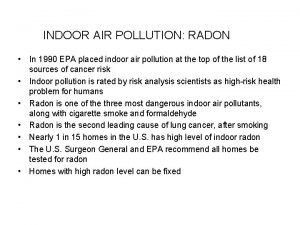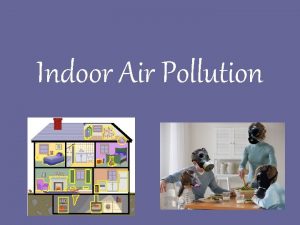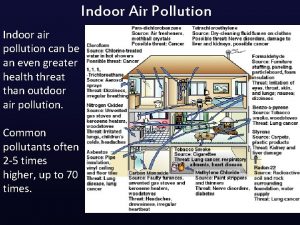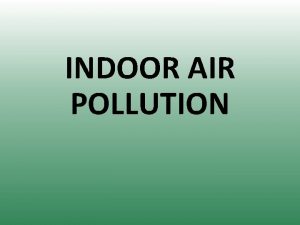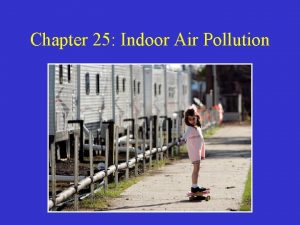Indoor Air Quality The quality of the air








- Slides: 8

Indoor Air Quality • The quality of the air in our homes and school may be worse than the air outside!

Sources of Indoor Air Pollution • VOC levels are consistently higher indoors (up to ten times higher) than outdoors. Examples include: paints and lacquers paint strippers cleaning supplies pesticides building materials and furnishings Photocopiers and printers correction fluids carbonless copy paper Glues and adhesives permanent markers

Sources of Indoor Air Pollution • Furnaces and poorly ventilated space heaters contribute carbon monoxide • Pressed wood (shelving) may contribute formaldehyde especially when new. • Mold – spores will always be present in air. Only become a problem where moisture allows mold to grow


Radon • Radon is a radioactive gas. • It comes from the natural decay of uranium that is found in nearly all soils. • It moves up through the ground to the air above and into your home through cracks and other holes in the foundation. • Your home traps radon inside, where it can build up. • Any home may have a radon problem. • Radon in indoor air is estimated to cause about 21, 000 lung cancer deaths each year in the United States. • EPA recommends all homes be tested for Radon

Asbestos • Sources include deteriorating, damaged, or disturbed insulation, fireproofing and floor tiles • The most dangerous asbestos fibers are too small to be visible. After they are inhaled, they can remain and accumulate in the lungs. • Asbestos can cause lung cancer, mesothelioma (a cancer of the chest and abdominal linings), and asbestosis (irreversible lung scarring that can be fatal). • Symptoms of these diseases do not show up until many years after exposure began.

Air Quality at School • Twenty percent of the U. S. population spend their days in our elementary and secondary schools. • In the mid-1990 s 1 in 5 of our nation's schools reported unsatisfactory indoor air quality • 1 in 4 schools reported ventilation as unsatisfactory. • Students are at greater risk because of the hours spent in school facilities and because children are especially susceptible to pollutants.

How is the Air Quality in your Home? • http: //www. youtube. com/watch? v=gci. Sp 5 X 40 t 0


